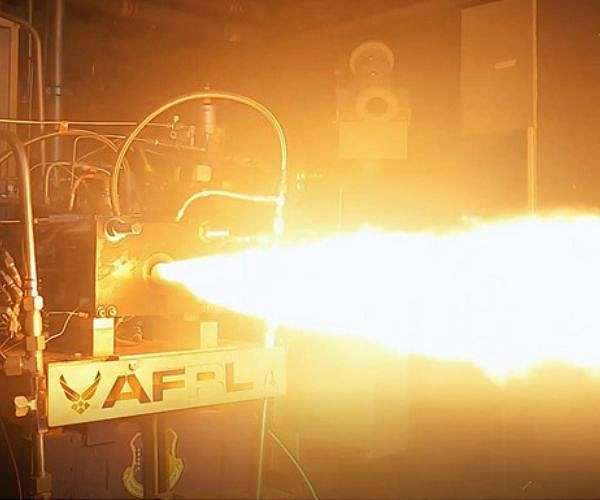The Air Force Research Laboratory’s (AFRL) Rocket Propulsion Division has achieved a significant milestone by designing, printing, building, and testing a unique single-block rocket-engine thrust chamber using an innovative additive manufacturing technique known as laser powder directed energy deposition (DED).
“AFRL’s investments in early advanced manufacturing techniques allow us to explore new areas of the design space for rocket engines and enable quicker design to testing cycles, from concept on a whiteboard to field evaluation,” remarked Dr. Javier Urzay, Chief of the Combustion Devices Branch.
DED, a method where metal powder is fused by high-power laser beams under controlled atmospheric conditions, offers substantial advantages over traditional methods such as laser powder bed fusion (LPBF). “It allows for the largest build box volume yet for thruster hardware, capable of producing parts up to seven feet tall. This capability, combined with reduced powder use and material waste, as well as real-time alloy blending, paves the way for harnessing next-generation superalloys’ strength, weight, and performance benefits,” explained Urzay.
Urzay added, “This technology enables us to pursue complex engine designs with fewer iterations, employing shape optimization, lightweight materials, and rapid manufacturing techniques.”
AFRL is integrating these advanced manufacturing processes with modern digital engineering frameworks, closely working with the U.S. space industry. These frameworks leverage artificial intelligence, machine learning, digital twins, 3D volumetric scanners, and computer-aided design (CAD) to revolutionize how rocket engine components such as thrust chambers, manifolds, and turbomachinery blades are made.
Edgar Felix, an aerospace engineer at the Combustion Devices Branch, noted, “While additive manufacturing presents many benefits for quicker and cheaper production, overcoming the technological challenges remains crucial for its broader adoption in the rocket propulsion sector.”
AFRL continues to address these challenges, particularly in creating materials robust enough for the extreme conditions rocket engines face. The agency’s collaboration with industry partners and government entities like NASA’s Marshall Space Flight Center is vital for advancing these technologies.
“This recent advancement in our additive manufacturing capabilities for rocket engines reflects our ongoing efforts to enhance collaborations with key industrial and governmental partners,” stated Urzay. “Their contributions are vital for our nation, and together, we form a formidable team.”
The AFRL Rocket Propulsion Division remains committed to innovating additive manufacturing techniques to enhance the production of both liquid and solid rocket motors.
Subscribe to AM Chronicle Newsletter to stay connected: https://bit.ly/3fBZ1mP
Follow us on LinkedIn: https://bit.ly/3IjhrFq
Visit for more interesting content on additive manufacturing: https://amchronicle.com


